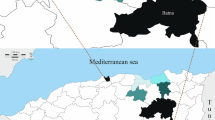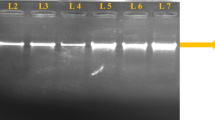Abstract
Conventional method of species identification in Eimeria employs phenotypic characters of the oocysts and the site of infection in the chicken intestine, which are subjective analyses. PCR-based identification of Eimeria spp. is known to be specific and sensitive. We used internal transcribed spacer 1 (ITS-1)-based nested PCR to follow the distribution of Eimeria spp. in the field, which may be of significant value in the management of coccidiosis in chickens. In the present study, intestinal samples of chicks from commercial poultry farms, in India, suspected of having contracted Eimeria infections were analyzed using ITS-1 PCR. The PCR-amplified ITS-1 regions were also sequenced from these samples. Of 26 field samples analyzed, 19 showed the presence of multiple infections of Eimeria spp. Incidence of Eimeria tenella (80%) was found to be highest in these samples followed by Eimeria mitis (53%), Eimeria acervulina (42%), Eimeria brunetti, and Eimeria maxima (23%). Incidence of Eimeria necatrix was found to be the lowest (15%) in the samples analyzed, while none of the samples analyzed showed the presence of ITS-1 sequence from Eimeria praecox. The ITS-1 sequences amplified from Eimeria spp. in the present study showed few variations from the ITS sequences available in the GenBank database. Further studies will be required to determine whether these differences are unique to geographical locations.


Similar content being viewed by others
References
Barta JR, Martin ED, Liberator PA, Dashkevicz M, Anderson JW, Feighner SD, Elbrecht A, Perkins-Barrow A, Jenkins MC, Danforth HD, Ruff MD, Profous-Juchelka H (1997) Phylogenetic relationships among eight Eimeria species infecting domestic fowl inferred using complete small subunit ribosomal DNA sequences. J Parasitol 83:262–271
Barta JR, Coles BA, Schito ML, Fernando MA, Martin A, Danforth HD (1998) Analysis of intra-specific variation among five strains of Eimeria maxima from North America. Int J Parasitol 28:485–492
Beck HP, Blake D, Dardé M-L, Felger I, Pedraza-Díaz S, Regidor-Cerrillo J, Gómez-Bautista M, Ortega-Mora LM, Putignani L, Shiels B, Tait A, Weir W (2009) Molecular approaches to diversity of populations of apicomplexan parasites. Int J Parasitol 39:175–189
Blake DP, Hesketh P, Archer A, Carroll F, Smith AL, Shirley MW (2004) Parasite genetics and the immune host: recombination between antigenic types of Eimeria maxima as an entree to the identification of protective antigens. Mol Biochem Parasitol 138:143–152
Cantacessi C, Riddell S, Morris GM, Doran T, Woods WG, Otranto D, Gasser RB (2008) Genetic characterization of three unique operational taxonomic units of Eimeria from chickens in Australia based on nuclear spacer ribosomal DNA. Vet Parasitol 152:226–234
Hnida J, Duszynski D (1999) Taxonomy and systematics of some Eimeria species of murid rodents as determined by the ITS-1 region of the ribosomal gene complex. Parasitol 119:349–357
Lew AE, Anderson GR, Minchin CM, Jeston PJ, Jorgensen WK (2003) Inter-and intra strain variation and PCR detection of the internal transcribed spacer l (ITS-1) sequences of Australian isolates of Eimeria species from chickens. Vet Parasitol 112:33–50
Lien YY, Sheu SC, Liu HJ, Chen SC, Tsai MY, Luo SC, Wu KC, Liu SS, Su HY (2007) Cloning and nucleotide sequencing of the second internal transcribed spacer of ribosomal DNA for three species of Eimeria from chickens in Taiwan. Vet J 173:184–189
Long PL, Joyner LP (1984) Problems in the identification of species of Eimeria. J Protozool 31:535–541
McDougald LR, Fuller L, Solis J (1986) Drug-sensitivity of 99 isolates of coccidia from broiler farms. Avian Dis 30:690–694
Mohanty S, Rajendran K (2003) 2020 vision for Indian poultry industry. Int J Poult Sci 2:139–143
Mugridge NB, Morrison DA, Jakel T, Heckeroth AR, Tenter AM, Johnson AM (2000) Effects of sequence alignment and structural domains of ribosomal DNA on phylogeny reconstruction for the protozoan family Sarcocystidae. Mol Biol Evol 17:1842–1853
Nicholas KB, Nicholas HB (1997) GeneDoc: a tool for editing and annotating multiple sequence alignments. Distributed by the author
Ruff MD (1999) Important parasites in poultry production systems. Vet Parasitol 84:337–347
Schnitzler BE, Thebo PL, Mattsson JG, Tomley FM, Shirley MW (1998) Development of a diagnostic PCR assay for the detection and discrimination of four pathogenic Eimeria species of the chicken. Avian Pathol 27:490–497
Schnitzler BE, Thebo PL, Tomley FM, Uggla A, Shirley MW (1999) PCR identification of chicken Eimeria species: a simplified read-out. Avian Pathol 28:89–93
Shirley MW, Smith AL, Tomley FM (2005) The biology of avian Eimeria with an emphasis on their control by vaccination. Adv Parasitol 60:285–330
Shirley MW, Smith AL, Blake DP (2007) Challenges in successful control of the avian coccidia. Vaccine 25:5540–5547
Smith AL, Hesketh P, Archer A, Shirley MW (2002) Antigenic diversity in Eimeria maxima and the influence of host genetics and immunization schedule on cross-protective immunity. Infect Immun 70:2472–2479
Stucki U, Braun R, Roditi I (1993) Eimeria tenella: characterization of a 5S ribosomal RNA repeat unit and its use as a species-specific probe. Exp Parasitol 76:68–75
Su Y-C, Fei AC-Y, Tsai F-M (2003) Differential diagnosis of five avian Eimeria species by polymerase chain reaction using primers derived from the internal transcribed spacer 1 (ITS-1) sequence. Vet Parasitol 117:221–227
Tamura K, Dudley J, Nei M, Kumar S (2007) MEGA4: molecular evolutionary genetics analysis (MEGA) software version 4.0. Mol Biol Evol 24:1596–1599
Woods WG, Richards G, Whithear KG, Anderson GR, Jorgensen WK, Gasser RB (2000) High-resolution electrophoretic procedures for the identification of five Eimeria species from chickens and detection of population variation. Electrophoresis 21:3558–3563
Zhao, Duszynski DW, Loker ES (2001) A simple method of DNA extraction for Eimeria species. J Microbiol Meth 44:131–137
Acknowledgments
The authors thank Dr. V. A. Srinivasan, Dr. D. Thiagarajan, and Mr. N. M. Ponnanna for critically reviewing the manuscript. The authors also thank Mr. N. Hanumantha Rao and Mr. P. Baji Babu for their technical help.
Author information
Authors and Affiliations
Corresponding author
Rights and permissions
About this article
Cite this article
Bhaskaran, M.S., Venkatesan, L., Aadimoolam, R. et al. Sequence diversity of internal transcribed spacer-1 (ITS-1) region of Eimeria infecting chicken and its relevance in species identification from Indian field samples. Parasitol Res 106, 513–521 (2010). https://doi.org/10.1007/s00436-009-1696-2
Received:
Accepted:
Published:
Issue Date:
DOI: https://doi.org/10.1007/s00436-009-1696-2




